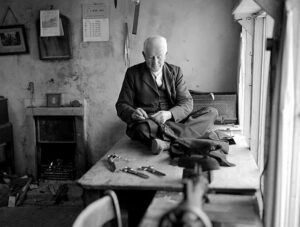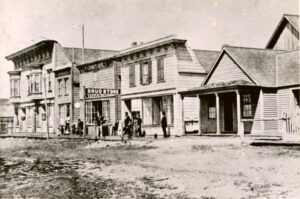
In today’s world of readymade clothes, we may not think much about where clothing came from in the late 1800’s on the coast. Depending on the wealth of the family, your clothing was made at home from what were called dry goods, or you used the services of a tailor or dressmaker.
One such service provider was William H. White (1817-1896), a native of London, who made clothing for the men of Mendocino City. Prior to 1861 he had been in the Ukiah Valley making pants and coats from tanned deerskins. Choosing to practice his trade in the biggest town in the county at the time he came west over the hills to practice his trade. Mendocino City’s business existed to provide for the needs of workers in the forests and sawmills, the crews of sailing vessels visiting the harbor, and farmers and ranchers.
Remember this was a time when everything arrived by ship. Passengers and freight arrived from the south and returned with loads of lumber, wood products, farm produce, fish, and more passengers. Among the deliveries came fabric, thread, pins and needles for the tailor’s trade.
While terms like shirting, fancy goods, linen, cotton, chambray, poplin, muslin and silk may be familiar to us today, what were Jaconets, lawn, duck, lisle, brilliantine, poil de chèvre, and delaine? These were all goods destined for tailors and dressmakers of those times.

William White set up his business in a small house he bought from William and Augustus Heeser in 1863. The lot was on Main St. and was 35’ x 80’ next to property owned by R. T. Rundle and he paid $250 for it. He lived and worked in the house and kept a horse in the back yard. It’s not known if he had a sewing machine in the early years as the public had some doubts about the quality of a garment made with a needle so thick it could sew through three layers of fabric. We do know for a fact he hand-sewed suits for 30 years.
Not all the fabric William White used came from the east, or abroad. California’s first woolen mill in San Francisco in 1859 conducted business with White. The tailor made garments of all sorts. Mail order work clothes or work wear purchased from a company store were fine for mill or woods work but for Sunday services and special occasions a suit, sewn to fit the wearer properly, a fancy shirt and a necktie were desired.
Active in his new community he was a family man and identified with the Ukiah Lodge of the Independent Order of Odd Fellows. On his death in 1896 it was reported “The Angel of Death had entered his door. A faithful worker he completed his labors on this plane box life and has gone higher up,” and was buried in Russian River Cemetery.